Jib Crane Prices: Everything You Need to Know for Informed Purchasing
Jib Crane Prices: Everything You Need to Know for Informed Purchasing
Unlock smart jib crane purchases with our guide. Master pricing strategies for optimal decisions. Your comprehensive purchasing companion awaits
In the field of material handling, jib cranes stand tall as versatile workhorses, offering efficient solutions for lifting and moving heavy loads in various industries. These specialized cranes come in different types, each designed to suit specific applications and space constraints. But before delving into the specifics of jib crane types and capabilities, it's essential to grasp the significance of understanding jib crane prices.
Jib cranes are ingenious mechanical devices characterized by their horizontal boom (or jib) attached to a vertical mast or wall-mounted pillar. This design allows for a wide range of motion, enabling users to position loads precisely within their workspace. Whether it's in manufacturing facilities, warehouses, construction sites, or even automotive garages, jib cranes play a crucial role in streamlining operations and enhancing productivity.
While the benefits of jib cranes are undeniable, navigating the landscape of jib crane prices can be daunting without proper guidance. The cost of a jib crane encompasses more than just the initial purchase price; it includes factors like installation, maintenance, and operational expenses over its lifespan. Therefore, having a solid understanding of jib crane prices is essential for making informed decisions that align with budgetary constraints and operational requirements.
Factors Influencing Jib Crane Prices
When it comes to purchasing a jib crane, several key factors influence the overall price tag. Understanding these factors is crucial for accurately budgeting and selecting the right crane to meet your needs. Let's explore each of these factors in detail:
- Load Capacity: The load capacity of a jib crane refers to the maximum weight it can safely lift and maneuver. Jib cranes come in a range of load capacities, from light-duty models capable of lifting a few hundred pounds to heavy-duty variants designed for loads exceeding several tons. As a general rule, higher load capacities command higher prices due to the need for stronger materials and structural reinforcements.
- Reach (Boom Length): The reach, or boom length, of a jib crane determines the distance it can extend horizontally to reach loads. Longer boom lengths provide greater coverage and flexibility but may come at a higher cost due to increased materials and engineering complexity. When evaluating jib crane prices, consider the optimal reach required for your specific lifting tasks and workspace layout.
- Material and Construction: The quality of materials and construction directly impacts the durability, reliability, and longevity of a jib crane. Cranes constructed from high-grade steel or aluminum alloys tend to command higher prices but offer superior strength, corrosion resistance, and longevity compared to cheaper alternatives. Investing in a well-built crane upfront can yield significant cost savings in terms of maintenance and replacement down the line.
- Installation Requirements: The complexity of installation can significantly affect the overall cost of a jib crane. Factors such as site preparation, foundation requirements, and accessibility can impact installation time and labor costs. Additionally, specialized installation techniques or equipment may be necessary for certain crane configurations, further adding to the total expense. Be sure to factor in installation costs when budgeting for your jib crane purchase.
- Brand and Manufacturer: The brand and reputation of the manufacturer can also influence jib crane prices. Established brands with a track record of quality and reliability may command premium prices, reflecting the perceived value and trust associated with their products. While opting for a reputable manufacturer can provide peace of mind and assurance of product performance, it's essential to weigh the cost against your budget and specific requirements.
- Additional Features and Accessories: Finally, the inclusion of additional features and accessories can impact the final price of a jib crane. Optional add-ons such as motorized trolleys, remote controls, safety features, and customizations tailored to specific applications can increase the upfront cost but may enhance functionality and efficiency in the long run. Evaluate the necessity and value of these extras based on your operational needs and budget constraints.
By carefully considering these factors and their respective impact on jib crane prices, you can make a well-informed decision that aligns with your budget and lifting requirements. In the following section, we'll delve into the process of determining your specific jib crane needs to facilitate a more targeted and cost-effective purchasing journey.
Determining Your Jib Crane Requirements
Before diving into the purchasing process, it's crucial to assess your specific requirements to ensure you select the right jib crane for your needs. Let's explore the key considerations in detail:
- Assessing Load Capacity Needs: Begin by evaluating the maximum weight of the loads you'll be lifting on a regular basis. Consider both the weight of individual items and any potential future growth in load size or weight. Choosing a jib crane with sufficient load capacity to accommodate your current and anticipated needs will prevent overloading and ensure safe lifting operations.
- Evaluating Space and Site Conditions: Take stock of your workspace layout and available floor space to determine the most suitable mounting option for your jib crane. Consider factors such as ceiling height, obstructions, and proximity to other equipment or structures. Free-standing, wall-mounted, mast type, or articulating jib cranes each have unique spatial requirements, so choose the option that best fits your site conditions and workflow.
- Understanding Usage Frequency and Environment: Consider how often the jib crane will be in use and the environmental conditions it will encounter. High-frequency usage may necessitate a more robust and durable crane capable of withstanding constant operation. Similarly, if the crane will be exposed to harsh environments such as extreme temperatures, moisture, or corrosive substances, opt for materials and coatings that offer enhanced protection against corrosion and wear.
- Considering Safety and Regulatory Requirements: Safety should always be a top priority when selecting a jib crane. Familiarize yourself with relevant safety standards and regulations governing crane operations in your industry and region. Ensure that the crane you choose meets or exceeds these requirements, including features such as overload protection, emergency stop controls, and proper operator training. Investing in a safe and compliant jib crane will mitigate the risk of accidents and ensure a safe working environment for your team.
By carefully evaluating these factors and aligning them with your specific operational needs and constraints, you can confidently proceed to the next step of researching jib crane prices and vendors. In the following section, we'll explore strategies for navigating the market and obtaining accurate pricing information to facilitate a well-informed purchasing decision.
Researching Jib Crane Prices
Armed with a clear understanding of your requirements, it's time to explore the market and gather pricing information for jib cranes. Here are some effective strategies for conducting thorough research:
- Online Resources and Marketplaces: Begin your search by browsing online resources and marketplaces dedicated to industrial equipment and machinery. Websites such as Alibaba, Thomasnet, and Machinery Trader offer a wide selection of jib cranes from various manufacturers and suppliers. Take advantage of search filters to narrow down options based on criteria such as load capacity, mounting type, and price range.
- Contacting Manufacturers and Suppliers: Reach out directly to jib crane manufacturers and suppliers to inquire about their product offerings and pricing. Many manufacturers have dedicated sales teams or customer service representatives who can provide detailed information and guidance tailored to your specific needs. Don't hesitate to ask questions about customization options, lead times, and any promotional discounts or incentives available.
- Requesting Quotes and Estimates: Once you've identified potential jib crane options, request quotes and estimates from multiple vendors to compare pricing and terms. Provide detailed specifications and requirements to ensure accurate quotes that account for all relevant factors, including load capacity, reach, installation, and any optional features or accessories. Be transparent about your budget constraints to facilitate meaningful negotiations and identify opportunities for cost savings.
- Comparing Prices and Features: As you receive quotes and estimates from different vendors, carefully compare pricing alongside key features and specifications. Look beyond the initial purchase price to consider factors such as installation costs, warranty coverage, and ongoing maintenance expenses. Evaluate the overall value proposition of each jib crane option based on its suitability for your application, reliability, and total cost of ownership over its lifespan.
By leveraging these research methods and conducting thorough price comparisons, you can make an informed decision that maximizes value and aligns with your budgetary constraints. In the next section, we'll delve into the intricacies of jib crane pricing structures and offer insights into budgeting and financing options to facilitate a seamless purchasing process.
Understanding Jib Crane Pricing Structures
When evaluating jib crane prices, it's essential to look beyond the initial sticker price and consider the broader picture of total cost of ownership. Let's explore the various components of jib crane pricing structures:
- Base Price vs. Total Cost of Ownership: The base price of a jib crane typically reflects the cost of the crane itself, excluding additional expenses such as installation, maintenance, and operating costs. To accurately assess the total cost of ownership, factor in all associated expenses over the crane's lifespan, including installation, ongoing maintenance, repairs, energy consumption, and potential downtime. While a crane with a lower base price may seem more budget-friendly upfront, it's essential to consider long-term costs to make a truly informed decision.
- Optional Add-ons and Customizations: Many jib crane manufacturers offer optional add-ons and customizations to tailor the crane to specific applications and preferences. While these extras can enhance functionality and efficiency, they often come at an additional cost. Common add-ons include motorized trolleys, remote controls, specialized hooks or attachments, and safety features such as collision avoidance systems or load monitoring devices. Consider the necessity and value of these optional features in relation to your operational requirements and budget constraints.
- Installation Costs and Services: Installation costs are a significant consideration when purchasing a jib crane. The complexity of installation, site preparation requirements, and labor rates can all impact the final installation cost. Some manufacturers and suppliers offer installation services as part of the package, while others may charge separately for installation or recommend third-party contractors. Be sure to obtain detailed quotes for installation services and factor these costs into your budget planning.
- Maintenance and Operating Expenses: Ongoing maintenance and operating expenses are critical factors to consider when budgeting for a jib crane. Regular maintenance, inspections, and repairs are essential to ensure optimal performance, reliability, and safety. Consider the cost of replacement parts, lubricants, and periodic servicing when calculating the total cost of ownership. Additionally, factor in energy consumption costs associated with crane operation, including electricity or fuel expenses.
By understanding the various components of jib crane pricing structures and considering both upfront and long-term costs, you can make a more informed decision that aligns with your budget and operational requirements. In the following section, we'll explore strategies for budgeting and financing your jib crane purchase to facilitate a smooth and cost-effective acquisition process.
Budgeting and Financing Your Jib Crane Purchase
As you prepare to invest in a jib crane, careful budgeting and consideration of financing options are essential to ensure a smooth and successful acquisition. Let's explore the key steps in this process:
- Setting a Realistic Budget: Begin by establishing a realistic budget for your jib crane purchase. Consider not only the upfront cost of the crane but also additional expenses such as installation, maintenance, and operating costs. Factor in any budget constraints or limitations while ensuring that your budget allows for the acquisition of a high-quality crane that meets your operational needs and safety requirements.
- Exploring Financing Options: Once you have a clear budget in mind, explore various financing options to facilitate your jib crane purchase. Options may include equipment financing, leasing, or rental agreements. Evaluate the terms, interest rates, and repayment schedules offered by different financing providers to choose the option that best suits your financial situation and cash flow requirements. Financing can help spread the cost of your crane purchase over time, making it more manageable and affordable.
- Factoring in Long-Term Costs: When budgeting for your jib crane purchase, don't overlook long-term costs associated with crane ownership, such as maintenance, repairs, and operating expenses. Consider the total cost of ownership over the crane's lifespan, including ongoing maintenance requirements, replacement parts, and energy consumption. Factoring in these long-term costs will help you make a more informed decision and avoid unexpected expenses down the line.
- Negotiating with Suppliers: When obtaining quotes and estimates from jib crane suppliers, don't hesitate to negotiate pricing and terms to secure the best possible deal. Be prepared to discuss your budget constraints and explore opportunities for cost savings, such as discounts for bulk purchases, package deals, or special promotions. Negotiating with suppliers can help ensure that you get the most value for your investment and may result in significant savings over time.
By carefully budgeting and exploring financing options, you can make a well-informed decision that aligns with your financial goals and operational requirements. Don't hesitate to negotiate with suppliers to secure the best possible deal and maximize the value of your jib crane purchase. In the following section, we'll offer some final tips for getting the best deal and ensuring a successful purchasing process.
Tips for Securing the Best Deal on Your Jib Crane Purchase
As you approach the final stages of your jib crane acquisition journey, here are some valuable tips to help you get the best possible deal:
- Buying in Bulk or Off-Season: Consider purchasing multiple jib cranes or other equipment simultaneously to take advantage of bulk discounts offered by suppliers. Additionally, buying during off-peak seasons or slower business periods may result in lower prices or special promotions as suppliers seek to boost sales.
- Seeking Multiple Quotes: Don't settle for the first quote you receive. Instead, reach out to multiple suppliers and request quotes for comparison. By obtaining multiple quotes, you can evaluate pricing, features, and terms to identify the most competitive offer that meets your requirements.
- Leveraging Supplier Relationships: Establishing strong relationships with jib crane suppliers can often lead to favorable pricing and terms. Consider working with suppliers you've successfully partnered with in the past or building rapport with new suppliers through ongoing communication and collaboration. Leveraging these relationships may result in discounts, expedited service, or preferential treatment.
- Considering Used or Refurbished Options: Don't overlook the possibility of purchasing a used or refurbished jib crane as a cost-effective alternative to buying new. Many reputable suppliers offer quality-checked, refurbished cranes at significantly lower prices than new models. Be sure to inspect used cranes thoroughly and inquire about any warranty or maintenance agreements to ensure reliability and peace of min
By implementing these tips and strategies, you can maximize your purchasing power and secure the best possible deal on your jib crane purchase. Remember to prioritize value and quality over price alone to ensure that your investment delivers long-term benefits and meets your operational needs effectively. With careful planning and negotiation, you can acquire a high-quality jib crane that enhances productivity and efficiency in your workplace.
Types of Jib Cranes
Jib cranes come in various configurations, each tailored to meet specific lifting needs and spatial constraints. Understanding the different types of jib cranes is essential for selecting the most suitable option for your workspace. Let's take a closer look at the four main types:
Free Standing Jib Cranes:
Free-standing jib cranes are self-supporting structures that do not require attachment to a building or structure. They feature a vertical support column securely anchored to the floor, providing stability while allowing for 360-degree rotation of the jib arm. Ideal for open floor layouts or areas where wall or column mounting is not feasible, free-standing jib cranes offer versatility and ease of installation.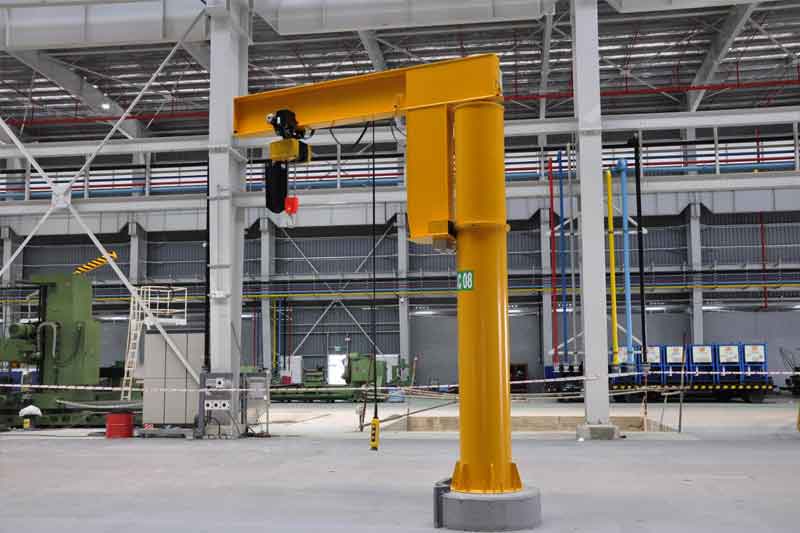
Floor mounted freestanding jib crane for sale 1 ton to 16 ton
Main parameters requested for Free Standing Jib Crane Price
To get a special price for a pillar jib crane, the main parameters to consider include:
- Load Capacity: Determine the maximum weight the crane needs to lift. This will influence the crane's design and components, affecting its price.
- Boom Length: Consider the reach required to access different areas within your workspace. Longer boom lengths may increase the crane's price due to additional materials and structural considerations.
- Mounting Type: Decide whether a floor-mounted or wall-mounted pillar jib crane is more suitable for your needs. Floor-mounted cranes require a stable foundation, while wall-mounted cranes utilize existing structures, potentially affecting pricing.
- Construction Material: Choose between steel or aluminum based on factors such as load capacity, durability, and environmental conditions. Steel cranes are typically more robust but may be more expensive than aluminum options.
- Rotation Angle: Determine the required rotation angle for the crane. Some pillar jib cranes offer 180-degree rotation, while others provide full 360-degree rotation. The rotation capability may impact the crane's price.
- Additional Features: Consider optional features such as motorized trolleys, remote controls, festoon systems, or specialized lifting attachments. These features can enhance the crane's functionality but may increase its price.
When seeking a special price for a pillar jib crane, it's essential to communicate your specific requirements clearly to suppliers or manufacturers. Additionally, inquire about any ongoing promotions, discounts for bulk orders, or customization options that may be available. By understanding your needs and exploring all available options, you can negotiate a competitive price for your pillar jib crane while ensuring it meets your operational requirements.
Special Considerations;
When buying pillar jib cranes, there are several special considerations to keep in mind to ensure you select the right crane for your needs. Here are some key factors to consider:
- Foundation Requirements: Pillar jib cranes require a stable and sturdy foundation to support the vertical mast and withstand the loads being lifte Ensure that the floor where the crane will be installed is capable of supporting the crane's weight and load capacity. Follow manufacturer guidelines for foundation specifications and installation to ensure safety and stability.
- Space and Clearance: Evaluate the available space in your facility and ensure that there is sufficient clearance around the pillar jib crane for safe operation and maintenance. Consider factors such as overhead obstructions, nearby equipment, and pedestrian traffic to avoid potential collisions and hazards.
- Swing Radius: Take into account the swing radius of the pillar jib crane, which is the distance from the center of rotation to the outer edge of the load when fully extende Ensure that there is adequate clearance for the crane's swing radius to avoid obstacles and obstructions in the workspace.
- Height Under Boom: Consider the height under the boom or hook height, which is the vertical distance from the floor to the bottom of the crane's boom. Ensure that there is sufficient clearance for lifting loads without interference from overhead structures or obstacles.
- Reach and Coverage: Determine the required reach and coverage area of the pillar jib crane to ensure that it can effectively reach all desired lifting locations within your workspace. Consider factors such as boom length, rotation angle, and load capacity to determine the optimal crane configuration for your needs.
- Environmental Conditions: Consider the environmental conditions in your facility, such as temperature extremes, humidity, and corrosive substances. Choose a pillar jib crane constructed from materials that offer resistance to corrosion and degradation in harsh environments to ensure longevity and reliability.
- Safety Features: Prioritize safety when selecting a pillar jib crane. Look for features such as overload protection, emergency stop controls, and safety interlocks to prevent accidents and ensure operator safety. Verify that the crane complies with relevant safety standards and regulations.
- Future Expansion: Anticipate future changes or expansions in your facility's layout or lifting requirements when selecting a pillar jib crane. Choose a crane with enough capacity and flexibility to accommodate future needs, minimizing the need for costly upgrades or replacements down the line.
By carefully considering these special considerations and evaluating your specific requirements, you can select a pillar jib crane that meets your lifting needs, fits seamlessly into your facility, and provides reliable performance and safety for years to come.
Send Your Quotation to Get Your Pilla Jib Crane Price
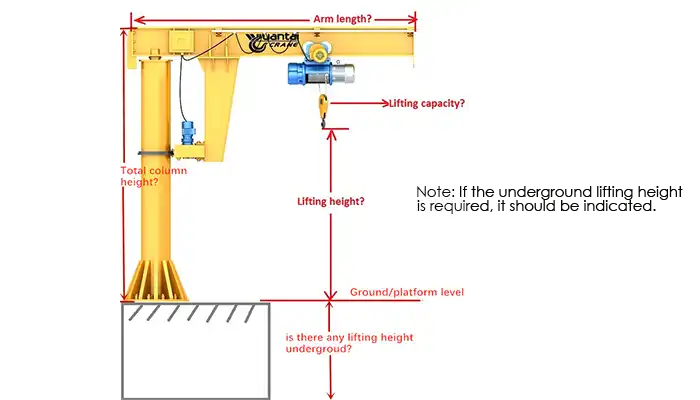
Here are the key parameters to consider when buying pillar jib cranes:
Crane type: Pillar Jib CRANES
Load Capacity:___________________________________
Boom Length/ Arm length: ___________________________________
Lifting Height: ___________________________________
Mounting Type:___________________________________
Construction Material:___________________________________
Rotation Angle:___________________________________
Special requirement: ___________________________________
Send your jib crane quotation to get your pillar jib crane price now.
Wall Mounted Jib Cranes:
Wall-mounted jib cranes are affixed directly to existing walls or columns, making efficient use of vertical space while leaving the floor unobstructe These cranes are popular in facilities with limited floor space or where floor-mounted options are impractical. With their ability to rotate up to 180 degrees, wall-mounted jib cranes provide targeted lifting capabilities within a defined area. 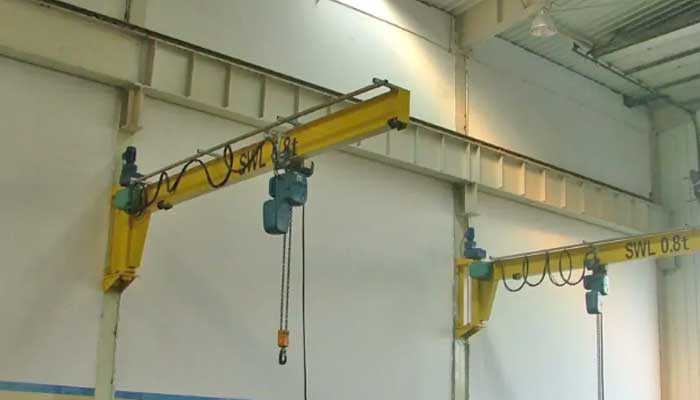
Wall mounted jib crane 500kg, 1 ton, 2 ton, 3 ton
Main parameters requested for Wall Mounted Jib Crane Price
Certainly! Here are the main parameters requested for determining the price of a wall-mounted jib crane, along with additional details:
- Load Capacity:Specify the maximum weight the crane needs to lift. This determines the crane's design, components, and structural requirements.
- Boom Length/Reach:Indicate the length of the boom required to reach desired lifting points. Longer booms may be necessary for accessing distant areas within the workspace.
- Height Under Boom:Provide the vertical distance from the floor to the underside of the boom. This ensures clearance for lifted loads and safe operation.
- Wall Structure Specifications:Detail the strength, material, and condition of the wall where the crane will be mounte This information is crucial for determining mounting methods and load-bearing capacity.
- Rotation Angle:Specify the required rotation angle of the crane. Some cranes offer full 360-degree rotation, while others may have limited rotation capabilities.
- Mounting Height:Determine the height at which the crane will be mounted on the wall. This affects reach, clearance, and installation requirements.
- Construction Material:Choose between materials such as steel or aluminum based on factors like load capacity, durability, and environmental conditions. Material selection impacts both the crane's performance and cost.
- Power Source:Specify the power source required for operation, such as electric, pneumatic, or manual. This determines the crane's compatibility with existing power systems.
- Additional Features:Consider optional features like motorized trolleys, remote controls, festoon systems, or specialized lifting attachments. These features enhance functionality but may increase the crane's price.
- Environmental Conditions:Describe the operating environment, including factors like temperature extremes, humidity, exposure to chemicals, or outdoor use. This influences material selection, corrosion resistance, and overall crane performance.
By providing detailed information on these parameters, suppliers can offer accurate quotes tailored to your specific requirements and ensure the wall-mounted jib crane meets your operational needs effectively.
Specical Considerations
When asking for the price of a wall-mounted jib crane, there are several special considerations to ensure you get an accurate and suitable quote. Here are the key factors to keep in mind:
- Wall Structure and Integrity: Verify the strength and condition of the wall where the crane will be mounte The wall must be capable of supporting the crane's load and withstanding the forces generated during operation. Provide details about the wall material (e.g., concrete, steel, brick) and any structural reinforcements in place or require
- Installation Requirements: Determine the complexity of the installation process. Consider whether additional structural supports, bracing, or modifications to the wall will be necessary. Installation requirements can significantly affect the overall cost.
- Space and Clearance: Assess the available space around the mounting are Ensure there is enough clearance for the crane's boom to rotate and for loads to move without obstruction. Provide details about the working area, including any potential obstacles or restrictions.
- Load Characteristics: Describe the type of loads that will be lifted, including their weight, dimensions, and center of gravity. If the loads have unique characteristics (e.g., uneven weight distribution, high center of gravity), this information is crucial for selecting the appropriate crane.
- Power Supply: Specify the available power supply for operating the crane. Include details such as voltage, phase, and any power restrictions. If the crane will use electric hoists or motorized trolleys, ensuring compatibility with your power supply is essential.
- Operational Environment: Detail the environmental conditions where the crane will be use Factors such as temperature extremes, humidity, exposure to chemicals or corrosive substances, and outdoor vs. indoor use can influence the crane's design and material selection.
- Usage Frequency: Provide information on how frequently the crane will be use Cranes intended for heavy, continuous use may require more robust components and higher-quality materials, affecting the price.
- Safety and Compliance: Ensure that the crane meets relevant safety standards and regulations. Consider additional safety features like overload protection, emergency stop buttons, and safety interlocks. Compliance with local, national, and industry-specific safety standards can impact the crane's design and cost.
- Customization Needs: Outline any specific customization requirements, such as special paint coatings, additional lifting attachments, or ergonomic features. Customizations can add to the cost but may be necessary for specific applications.
- Warranty and After-Sales Support: Inquire about the warranty period and the availability of after-sales support, including maintenance services and spare parts. A comprehensive warranty and reliable support can add value to your investment.
By addressing these special considerations and providing detailed information, you can ensure that the quotes you receive are accurate and tailored to your specific needs. This will help you select a wall-mounted jib crane that is both cost-effective and suitable for your operational requirements.
Send Your Quotation and Get CustomWall Mounted Jib Crane Price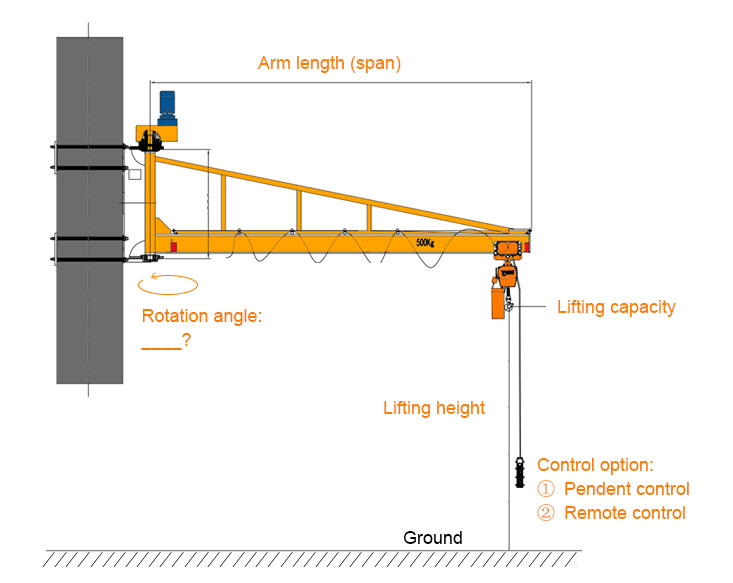
Wall mounted jib crane parameters requested to confirm the wall jib crane price
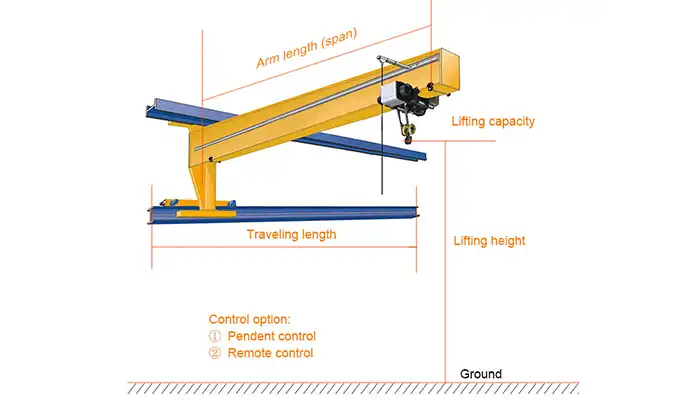
Wall travelling jib crane parameters to confirm the travelling jib crane price
When requesting a price for a wall-mounted jib crane, you should provide the following key parameters:
Crane Types: Wall mounted or wall travelling types
Load Capacity:___________________________________
Boom Length/Reach:___________________________________
Height Under Boom/ Lifting Height :___________________________________
Wall Structure Specifications (strength and material):
Rotation Angle:___________________________________
Mounting Height:___________________________________
Construction Material:___________________________________
Additional Features :___________________________________(e.g., motorized trolleys, remote controls, festoon systems)
Environmental Conditions:___________________________________ (e.g., indoor/outdoor use, corrosive environments)
Articulating Jib Cranes:
Articulating jib cranes, also known as knuckle jib cranes or manipulator arms, feature a multi-segmented jib arm with articulating joints, allowing for precise positioning of loads in confined or hard-to-reach spaces. Unlike traditional jib cranes with fixed boom lengths, articulating jib cranes offer greater flexibility and maneuverability, making them ideal for tasks that demand precision and agility, such as assembly lines or machining operations.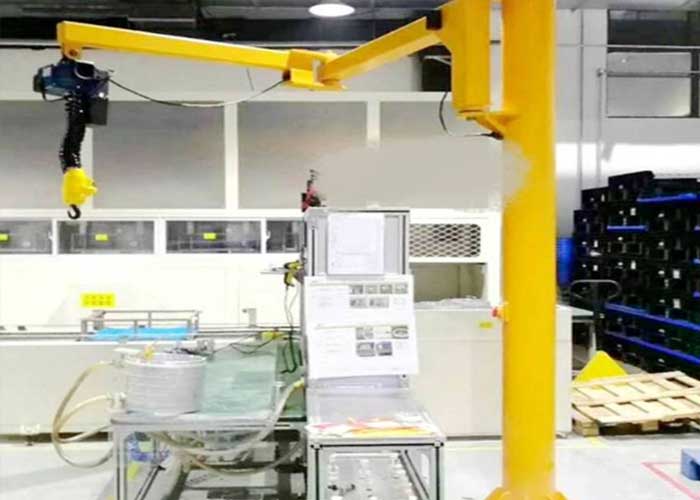
When requesting a price for an articulating jib crane, you should provide specific parameters to get an accurate quote. Additionally, several considerations need to be addressed to ensure you choose the right crane for your needs. Here are the main parameters and considerations:
Main Parameters:
- Load Capacity:Specify the maximum weight the crane needs to lift. This impacts the crane's design and components, directly affecting its price.
- Boom Length and Reach:Indicate the length of each arm of the articulating jib crane and the overall reach. Articulating arms typically provide greater flexibility and coverage, so precise measurements are essential.
- Height Under Boom:Provide the vertical distance from the floor to the underside of the boom. Ensure this height accommodates your load and operational requirements without interference.
- Rotation Angle:Specify the rotation capabilities of the crane. Articulating jib cranes often offer 360-degree rotation for one or both arms, but details on the required rotation angles are necessary.
- Mounting Type:Decide between wall-mounted, floor-mounted, or ceiling-mounted options. The mounting type affects installation complexity and cost.
- Construction Material:Choose between materials like steel or aluminum based on load capacity, durability, and environmental conditions. This affects the crane's weight, corrosion resistance, and cost.
- Power Source:If the crane is motorized, specify the required power source (electric, pneumatic, or manual operation). Include details such as voltage and phase for electric models.
- Additional Features:Consider optional features such as motorized trolleys, remote controls, festoon systems, or specialized lifting attachments. These features enhance functionality but may increase the price.
- Environmental Conditions:Detail the operating environment, such as temperature extremes, humidity, exposure to chemicals, or outdoor use. These conditions impact material selection and corrosion resistance requirements.
Considerations:
- Space and Clearance:Evaluate the available space around the mounting are Ensure enough clearance for the crane's arms to articulate and move loads without obstruction. Consider overhead and lateral space.
- Installation Requirements:Assess the complexity of installation. Wall or ceiling-mounted cranes may require additional structural support. Floor-mounted cranes need a stable foundation. Installation costs can vary significantly based on these factors.
- Usage Frequency:Determine how often the crane will be use Frequent or continuous use may require more robust components and higher-quality materials, impacting both initial cost and long-term maintenance.
- Safety Features:Prioritize safety by ensuring the crane includes necessary features like overload protection, emergency stop controls, and safety interlocks. Compliance with relevant safety standards and regulations is essential.
- Load Characteristics:Describe the types of loads, including weight, dimensions, and any special handling requirements. This information is crucial for selecting the right lifting attachments and ensuring safe operation.
- Future Expansion:Consider potential future changes or expansions in your facility or operational needs. Selecting a crane with some flexibility for future requirements can be more cost-effective in the long run.
- Maintenance and Support:Inquire about maintenance requirements and the availability of after-sales support, including spare parts and service plans. A reliable support system adds value to your investment.
- Warranty:Check the warranty period and coverage details. A comprehensive warranty can provide peace of mind and protect your investment.
By providing detailed information on these parameters and considerations, you can obtain an accurate quote and select an articulating jib crane that meets your operational needs effectively and safely.
Send Your Ariculating Jib Crane Qutation to Get Your Jib Crane Price
Main Parameters:
Load Capacity:___________________________________
Boom Length and Reach:___________________________________
Height Under Boom:___________________________________
Rotation Angle:___________________________________
Mounting Type:___________________________________
Power Source:___________________________________
Additional Features:___________________________________
Environmental Conditions:___________________________________
Conclusion: Mastering Jib Crane Prices
As we wrap up our comprehensive guide on understanding jib crane prices, let's reflect on the key points and considerations to keep in mind:
- Summary of Key Points: Throughout this guide, we've explored the various factors influencing jib crane prices, including load capacity, reach, materials, installation requirements, and optional features. We've discussed the importance of assessing your specific requirements, researching pricing options, and budgeting effectively to make an informed purchasing decision.
- Importance of Research and Planning: Research and planning are essential steps in the jib crane acquisition process. By thoroughly evaluating your lifting needs, space constraints, and budgetary considerations, you can identify the most suitable crane option and negotiate the best possible deal with suppliers. Remember to explore financing options, seek multiple quotes, and leverage supplier relationships to optimize your purchasing experience.
- Final Considerations before Purchasing: Before finalizing your jib crane purchase, carefully review all pricing structures, terms, and conditions to ensure clarity and transparency. Consider the total cost of ownership, including installation, maintenance, and operating expenses, to make a well-rounded decision that aligns with your long-term goals and budget constraints. Don't hesitate to ask questions, negotiate pricing, and seek clarification on any concerns before committing to a purchase.
- Resources for Further Assistance or Information: If you require further assistance or information regarding jib crane prices or purchasing options, don't hesitate to reach out to jib crane manufacturers, suppliers, or industry experts for guidance. Online forums, trade publications, and professional associations can also provide valuable insights and resources to support your decision-making process.
In conclusion, mastering jib crane prices requires a combination of careful research, strategic planning, and effective negotiation. By understanding the factors influencing pricing, setting realistic budgets, and exploring financing options, you can acquire a high-quality jib crane that meets your operational needs and delivers long-term value for your business. Thank you for joining us on this journey, and best of luck with your jib crane purchase!




